2019 DODGE CHARGER air condition
[x] Cancel search: air conditionPage 397 of 560
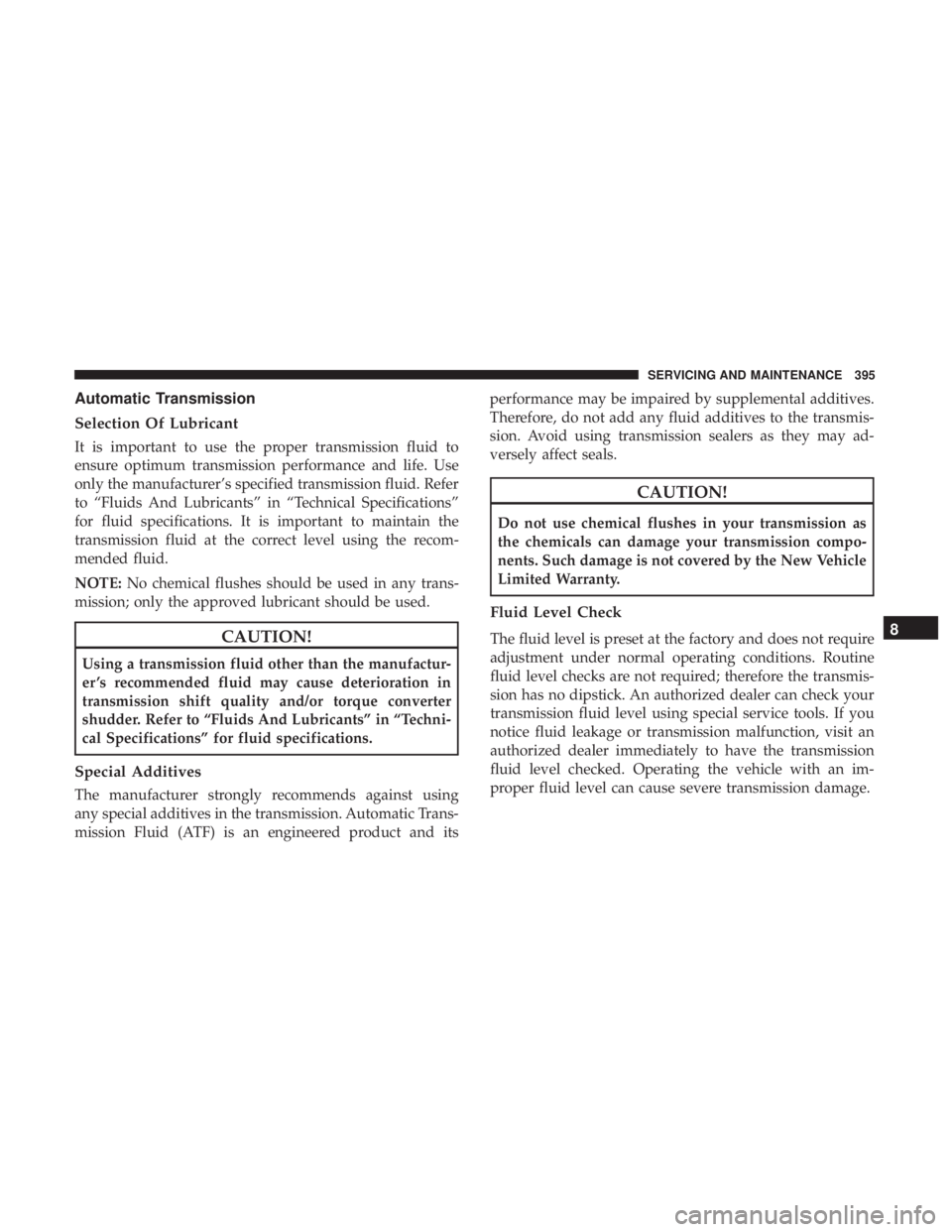
Automatic Transmission
Selection Of Lubricant
It is important to use the proper transmission fluid to
ensure optimum transmission performance and life. Use
only the manufacturer’s specified transmission fluid. Refer
to “Fluids And Lubricants” in “Technical Specifications”
for fluid specifications. It is important to maintain the
transmission fluid at the correct level using the recom-
mended fluid.
NOTE:No chemical flushes should be used in any trans-
mission; only the approved lubricant should be used.
CAUTION!
Using a transmission fluid other than the manufactur-
er ’s recommended fluid may cause deterioration in
transmission shift quality and/or torque converter
shudder. Refer to “Fluids And Lubricants” in “Techni-
cal Specifications” for fluid specifications.
Special Additives
The manufacturer strongly recommends against using
any special additives in the transmission. Automatic Trans-
mission Fluid (ATF) is an engineered product and its performance may be impaired by supplemental additives.
Therefore, do not add any fluid additives to the transmis-
sion. Avoid using transmission sealers as they may ad-
versely affect seals.
CAUTION!
Do not use chemical flushes in your transmission as
the chemicals can damage your transmission compo-
nents. Such damage is not covered by the New Vehicle
Limited Warranty.
Fluid Level Check
The fluid level is preset at the factory and does not require
adjustment under normal operating conditions. Routine
fluid level checks are not required; therefore the transmis-
sion has no dipstick. An authorized dealer can check your
transmission fluid level using special service tools. If you
notice fluid leakage or transmission malfunction, visit an
authorized dealer immediately to have the transmission
fluid level checked. Operating the vehicle with an im-
proper fluid level can cause severe transmission damage.8
SERVICING AND MAINTENANCE 395
Page 398 of 560
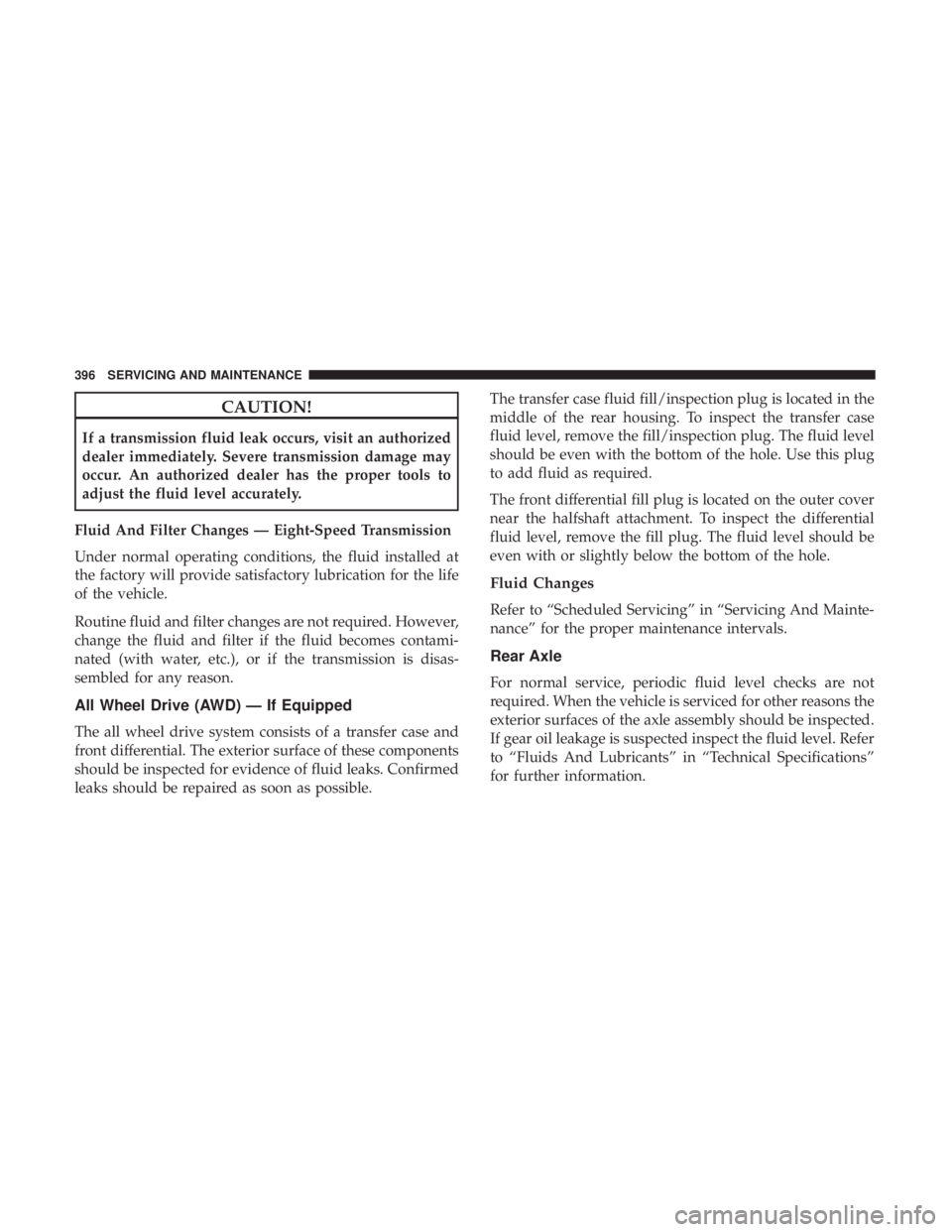
CAUTION!
If a transmission fluid leak occurs, visit an authorized
dealer immediately. Severe transmission damage may
occur. An authorized dealer has the proper tools to
adjust the fluid level accurately.
Fluid And Filter Changes — Eight-Speed Transmission
Under normal operating conditions, the fluid installed at
the factory will provide satisfactory lubrication for the life
of the vehicle.
Routine fluid and filter changes are not required. However,
change the fluid and filter if the fluid becomes contami-
nated (with water, etc.), or if the transmission is disas-
sembled for any reason.
All Wheel Drive (AWD) — If Equipped
The all wheel drive system consists of a transfer case and
front differential. The exterior surface of these components
should be inspected for evidence of fluid leaks. Confirmed
leaks should be repaired as soon as possible. The transfer case fluid fill/inspection plug is located in the
middle of the rear housing. To inspect the transfer case
fluid level, remove the fill/inspection plug. The fluid level
should be even with the bottom of the hole. Use this plug
to add fluid as required.
The front differential fill plug is located on the outer cover
near the halfshaft attachment. To inspect the differential
fluid level, remove the fill plug. The fluid level should be
even with or slightly below the bottom of the hole.
Fluid Changes
Refer to “Scheduled Servicing” in “Servicing And Mainte-
nance” for the proper maintenance intervals.
Rear Axle
For normal service, periodic fluid level checks are not
required. When the vehicle is serviced for other reasons the
exterior surfaces of the axle assembly should be inspected.
If gear oil leakage is suspected inspect the fluid level. Refer
to “Fluids And Lubricants” in “Technical Specifications”
for further information.
396 SERVICING AND MAINTENANCE
Page 410 of 560
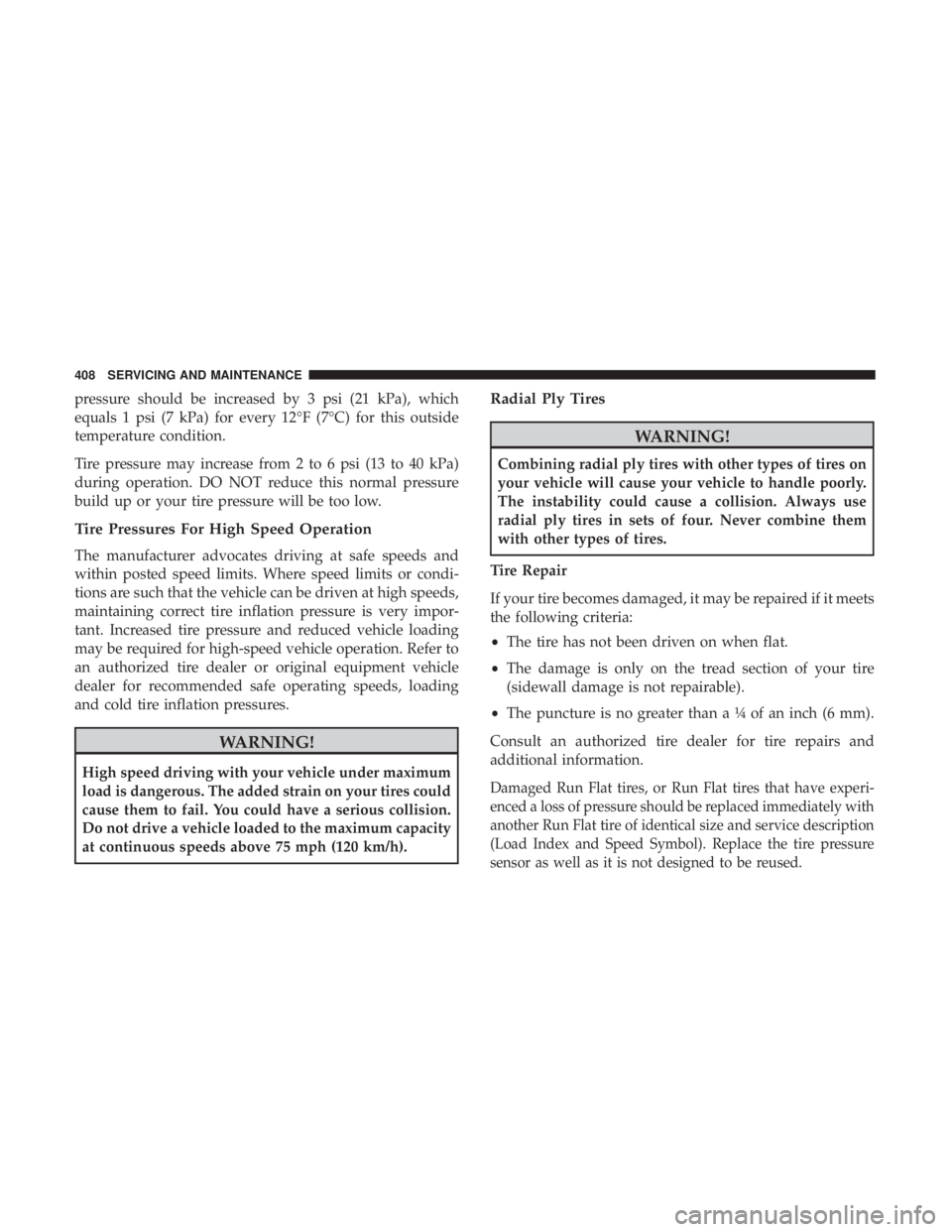
pressure should be increased by 3 psi (21 kPa), which
equals 1 psi (7 kPa) for every 12°F (7°C) for this outside
temperature condition.
Tire pressure may increase from 2 to 6 psi (13 to 40 kPa)
during operation. DO NOT reduce this normal pressure
build up or your tire pressure will be too low.
Tire Pressures For High Speed Operation
The manufacturer advocates driving at safe speeds and
within posted speed limits. Where speed limits or condi-
tions are such that the vehicle can be driven at high speeds,
maintaining correct tire inflation pressure is very impor-
tant. Increased tire pressure and reduced vehicle loading
may be required for high-speed vehicle operation. Refer to
an authorized tire dealer or original equipment vehicle
dealer for recommended safe operating speeds, loading
and cold tire inflation pressures.
WARNING!
High speed driving with your vehicle under maximum
load is dangerous. The added strain on your tires could
cause them to fail. You could have a serious collision.
Do not drive a vehicle loaded to the maximum capacity
at continuous speeds above 75 mph (120 km/h).
Radial Ply Tires
WARNING!
Combining radial ply tires with other types of tires on
your vehicle will cause your vehicle to handle poorly.
The instability could cause a collision. Always use
radial ply tires in sets of four. Never combine them
with other types of tires.
Tire Repair
If your tire becomes damaged, it may be repaired if it meets
the following criteria:
• The tire has not been driven on when flat.
• The damage is only on the tread section of your tire
(sidewall damage is not repairable).
• The puncture is no greater thana¼ofaninch (6 mm).
Consult an authorized tire dealer for tire repairs and
additional information.
Damaged Run Flat tires, or Run Flat tires that have experi-
enced a loss of pressure should be replaced immediately with
another Run Flat tire of identical size and service description
(Load Index and Speed Symbol). Replace the tire pressure
sensor as well as it is not designed to be reused.
408 SERVICING AND MAINTENANCE
Page 411 of 560
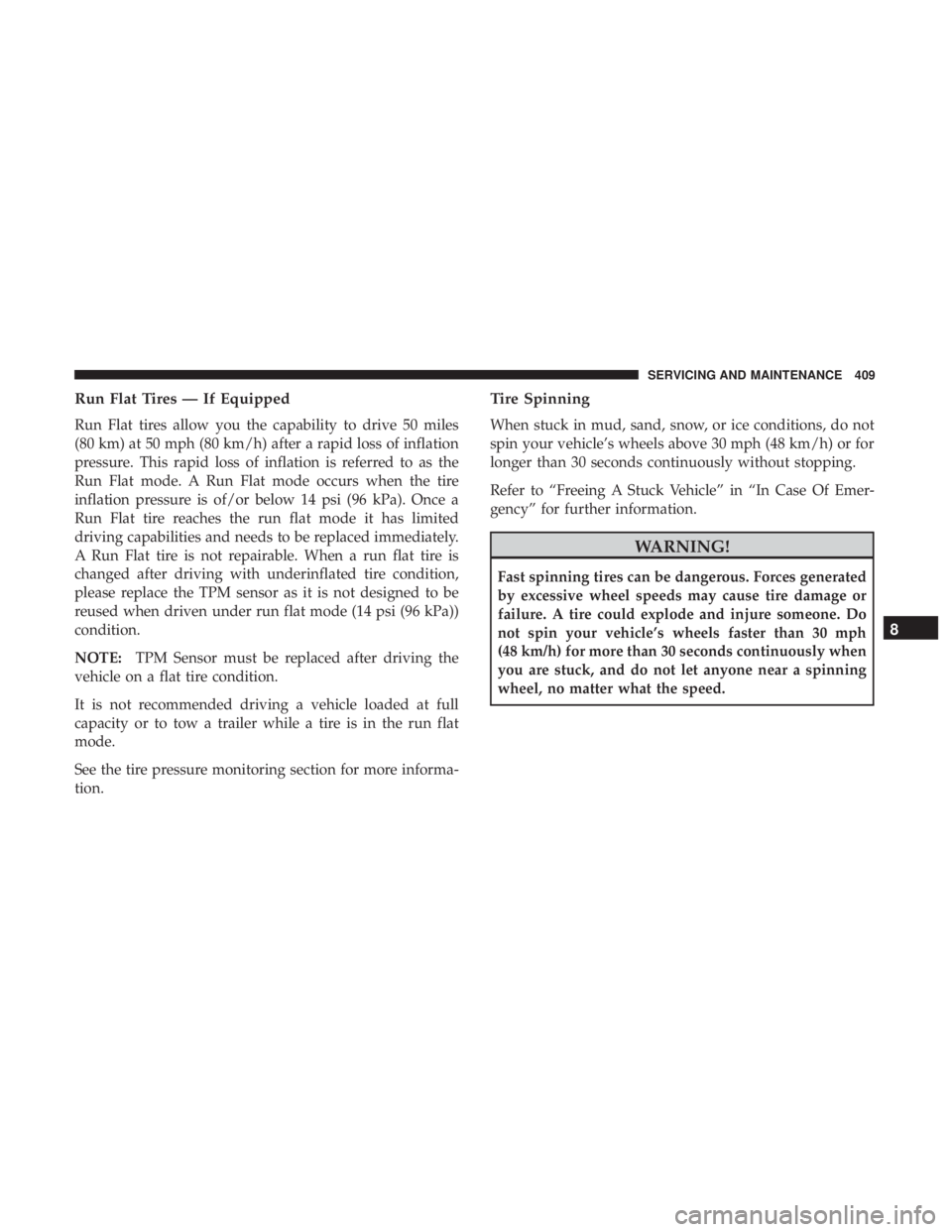
Run Flat Tires — If Equipped
Run Flat tires allow you the capability to drive 50 miles
(80 km) at 50 mph (80 km/h) after a rapid loss of inflation
pressure. This rapid loss of inflation is referred to as the
Run Flat mode. A Run Flat mode occurs when the tire
inflation pressure is of/or below 14 psi (96 kPa). Once a
Run Flat tire reaches the run flat mode it has limited
driving capabilities and needs to be replaced immediately.
A Run Flat tire is not repairable. When a run flat tire is
changed after driving with underinflated tire condition,
please replace the TPM sensor as it is not designed to be
reused when driven under run flat mode (14 psi (96 kPa))
condition.
NOTE:TPM Sensor must be replaced after driving the
vehicle on a flat tire condition.
It is not recommended driving a vehicle loaded at full
capacity or to tow a trailer while a tire is in the run flat
mode.
See the tire pressure monitoring section for more informa-
tion.
Tire Spinning
When stuck in mud, sand, snow, or ice conditions, do not
spin your vehicle’s wheels above 30 mph (48 km/h) or for
longer than 30 seconds continuously without stopping.
Refer to “Freeing A Stuck Vehicle” in “In Case Of Emer-
gency” for further information.
WARNING!
Fast spinning tires can be dangerous. Forces generated
by excessive wheel speeds may cause tire damage or
failure. A tire could explode and injure someone. Do
not spin your vehicle’s wheels faster than 30 mph
(48 km/h) for more than 30 seconds continuously when
you are stuck, and do not let anyone near a spinning
wheel, no matter what the speed.
8
SERVICING AND MAINTENANCE 409
Page 422 of 560
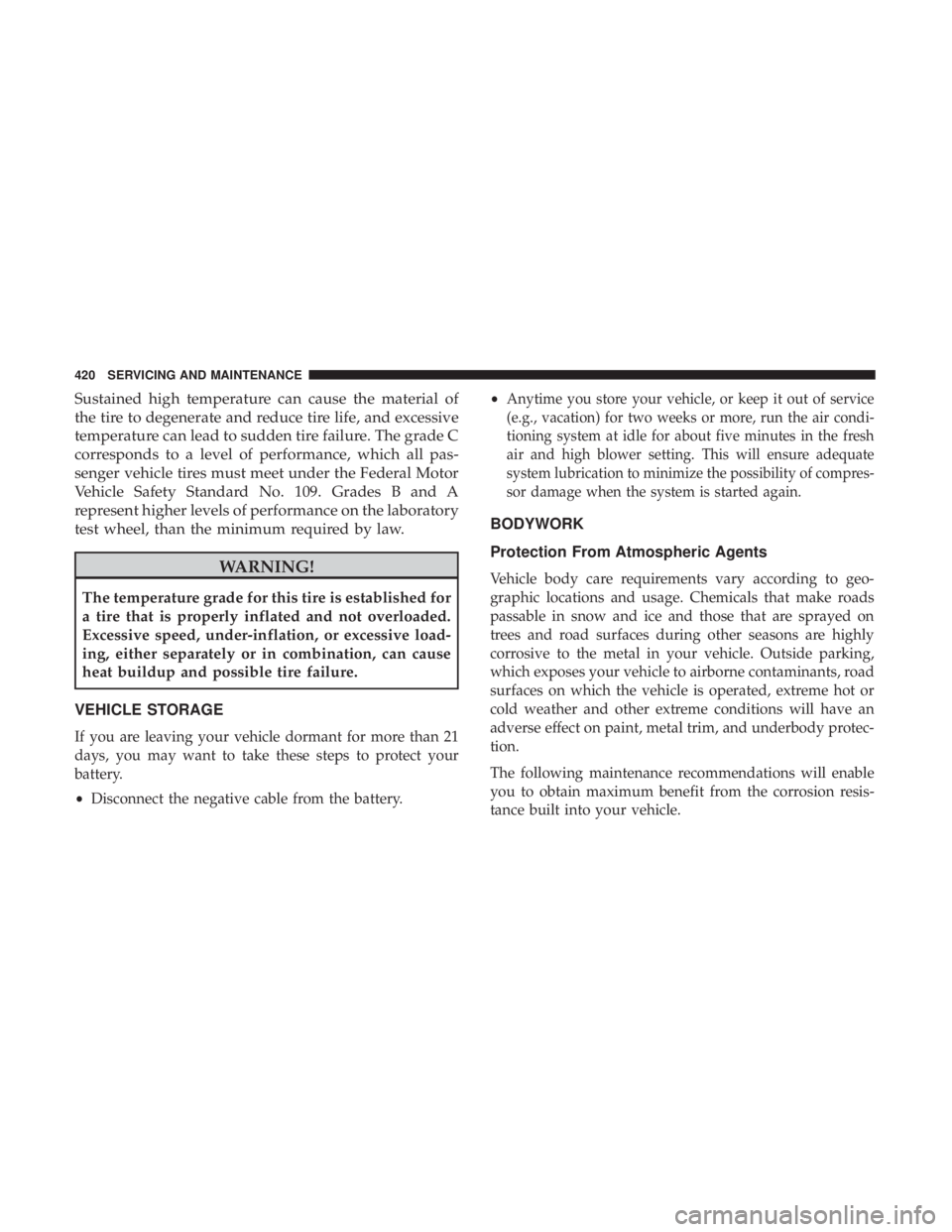
Sustained high temperature can cause the material of
the tire to degenerate and reduce tire life, and excessive
temperature can lead to sudden tire failure. The grade C
corresponds to a level of performance, which all pas-
senger vehicle tires must meet under the Federal Motor
Vehicle Safety Standard No. 109. Grades B and A
represent higher levels of performance on the laboratory
test wheel, than the minimum required by law.
WARNING!
The temperature grade for this tire is established for
a tire that is properly inflated and not overloaded.
Excessive speed, under-inflation, or excessive load-
ing, either separately or in combination, can cause
heat buildup and possible tire failure.
VEHICLE STORAGE
If you are leaving your vehicle dormant for more than 21
days, you may want to take these steps to protect your
battery.
• Disconnect the negative cable from the battery. •
Anytime you store your vehicle, or keep it out of service
(e.g., vacation) for two weeks or more, run the air condi-
tioning system at idle for about five minutes in the fresh
air and high blower setting. This will ensure adequate
system lubrication to minimize the possibility of compres-
sor damage when the system is started again.
BODYWORK
Protection From Atmospheric Agents
Vehicle body care requirements vary according to geo-
graphic locations and usage. Chemicals that make roads
passable in snow and ice and those that are sprayed on
trees and road surfaces during other seasons are highly
corrosive to the metal in your vehicle. Outside parking,
which exposes your vehicle to airborne contaminants, road
surfaces on which the vehicle is operated, extreme hot or
cold weather and other extreme conditions will have an
adverse effect on paint, metal trim, and underbody protec-
tion.
The following maintenance recommendations will enable
you to obtain maximum benefit from the corrosion resis-
tance built into your vehicle.
420 SERVICING AND MAINTENANCE
Page 514 of 560
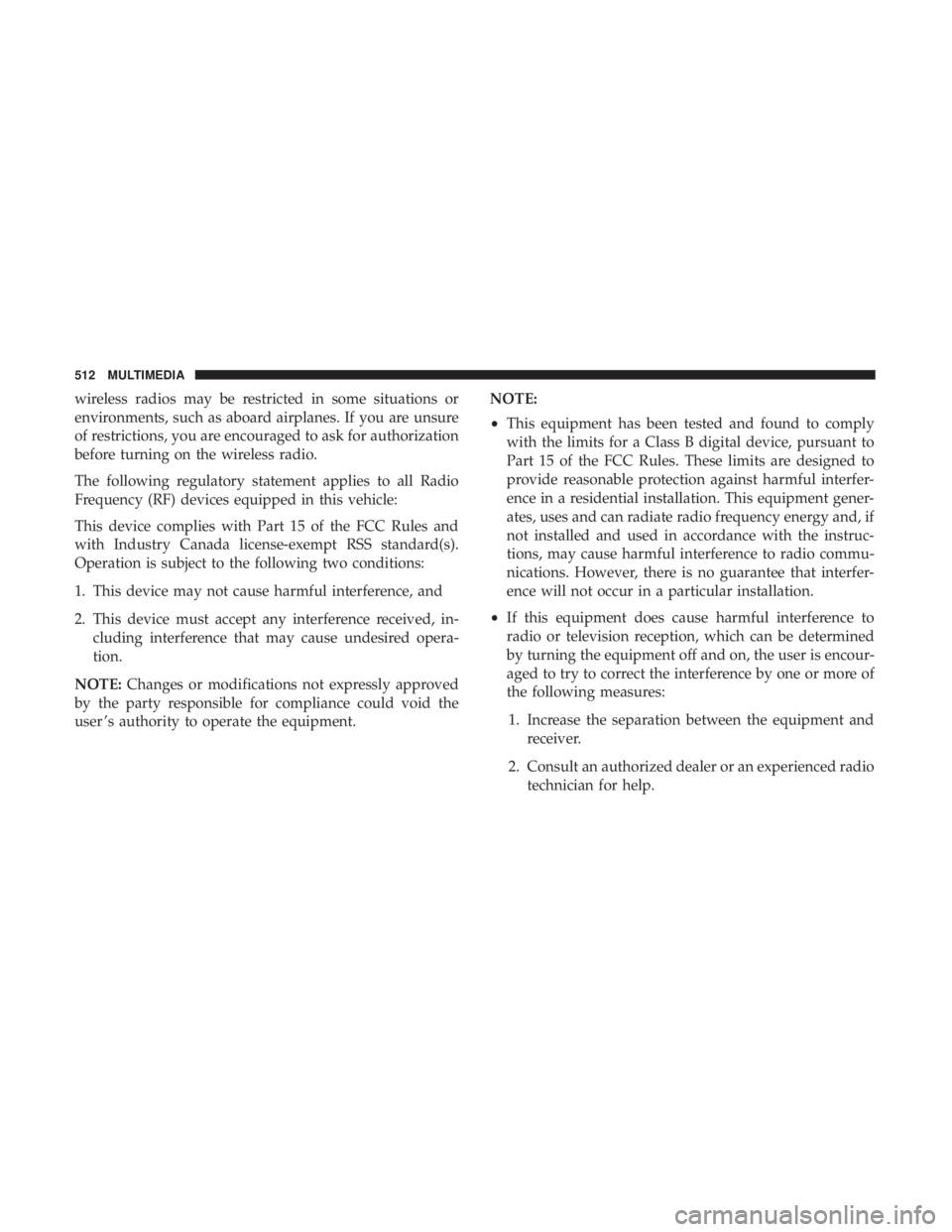
wireless radios may be restricted in some situations or
environments, such as aboard airplanes. If you are unsure
of restrictions, you are encouraged to ask for authorization
before turning on the wireless radio.
The following regulatory statement applies to all Radio
Frequency (RF) devices equipped in this vehicle:
This device complies with Part 15 of the FCC Rules and
with Industry Canada license-exempt RSS standard(s).
Operation is subject to the following two conditions:
1. This device may not cause harmful interference, and
2. This device must accept any interference received, in-cluding interference that may cause undesired opera-
tion.
NOTE: Changes or modifications not expressly approved
by the party responsible for compliance could void the
user ’s authority to operate the equipment. NOTE:
•
This equipment has been tested and found to comply
with the limits for a Class B digital device, pursuant to
Part 15 of the FCC Rules. These limits are designed to
provide reasonable protection against harmful interfer-
ence in a residential installation. This equipment gener-
ates, uses and can radiate radio frequency energy and, if
not installed and used in accordance with the instruc-
tions, may cause harmful interference to radio commu-
nications. However, there is no guarantee that interfer-
ence will not occur in a particular installation.
• If this equipment does cause harmful interference to
radio or television reception, which can be determined
by turning the equipment off and on, the user is encour-
aged to try to correct the interference by one or more of
the following measures:
1. Increase the separation between the equipment and receiver.
2. Consult an authorized dealer or an experienced radio technician for help.
512 MULTIMEDIA
Page 542 of 560

About Your Brakes........................ .428
Adaptive Cruise Control (ACC) (Cruise Control) . . . .253
Adding Engine Coolant (Antifreeze) .............390
Adding Fuel ............................. .287
Adding Washing Fluid ...................... .374
Additives, Fuel ........................... .431
Adjust Forward ................................48
Rearward ...............................48
AirBag ................................ .191
Advance Front Air Bag ....................191
Air Bag Operation ....................... .193
Air Bag Warning Light .....................190
Driver Knee Air Bag ..................... .194
Enhanced Accident Response .............200, 358
Event Data Recorder (EDR) .................358
FrontAirBag .......................... .191
If Deployment Occurs .....................199
Knee Impact Bolsters ..................... .193
Maintaining Your Air Bag System .............201
Maintenance ........................... .201
Redundant Air Bag Warning Light ............191
Side Air Bags .......................... .194
Transporting Pets ....................... .219
Air Bag Light ...................... .136, 190, 220Air Cleaner, Engine (Engine Air Cleaner Filter)
......379
Air Conditioner Maintenance ..................380
Air Conditioner Refrigerant ................380, 381
Air Conditioner System ..................... .380
Air Conditioning ...................... .79, 85, 91
Air Conditioning Filter ....................93, 381
Air Conditioning, Operating Tips ................92
Air Filter ............................... .379
Air Pressure Tires................................. .407
Alarm Arm The System ...................... .35, 36
Panic ..................................22
Rearm The System ........................36
Security
Alarm....................... .34, 140
Alarm System Security Alarm ...........................34
All Wheel Drive Towing ............................... .357
All Wheel Drive (AWD) ..................... .396
Alterations/Modifications Vehicle .................................5
Android Auto ............................ .529
Antifreeze (Engine Coolant) ................389, 436
Disposal .............................. .392
540 INDEX
Page 546 of 560
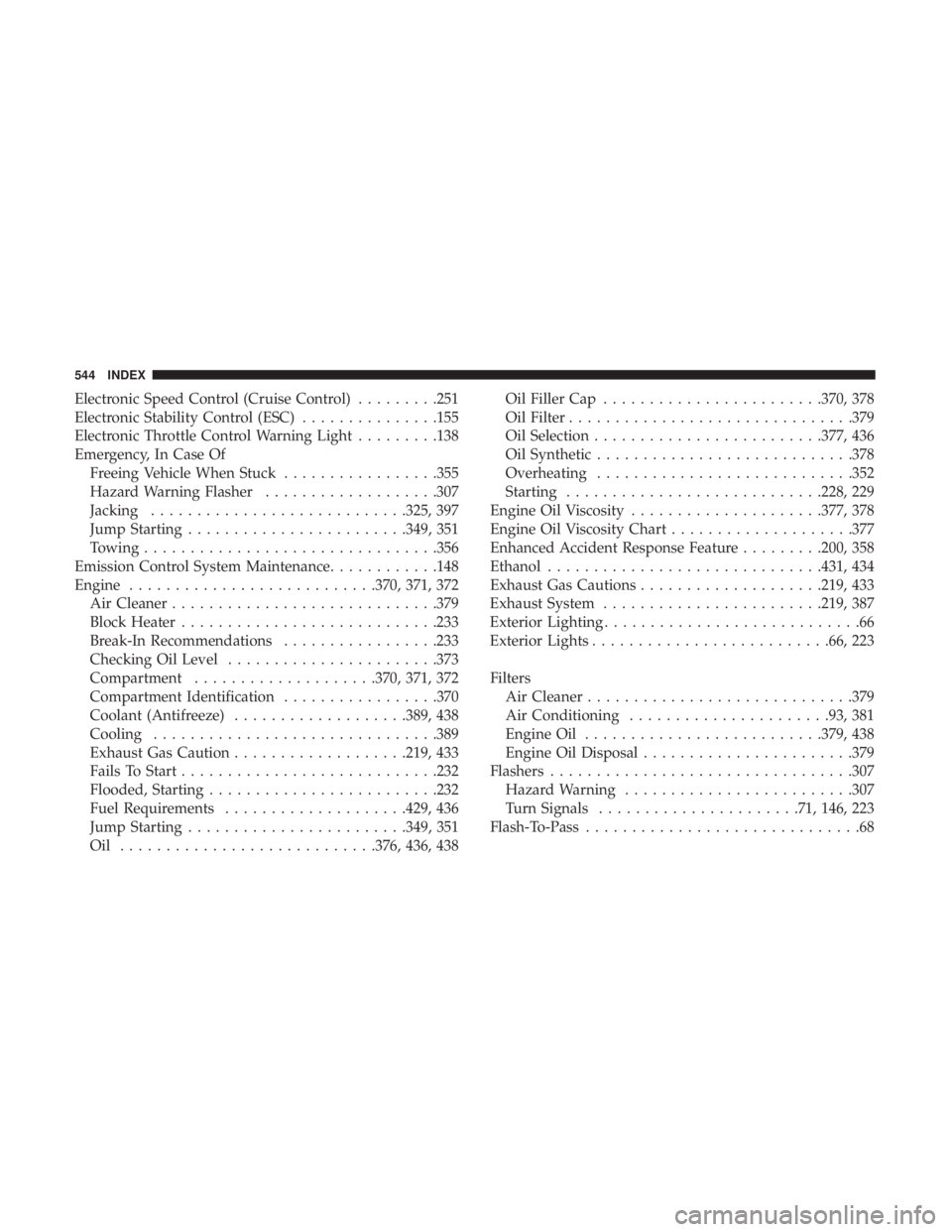
Electronic Speed Control (Cruise Control).........251
Electronic Stability Control (ESC) ...............155
Electronic Throttle Control Warning Light .........138
Emergency, In Case Of Freeing Vehicle When Stuck .................355
Hazard Warning Flasher ...................307
Jacking ........................... .325, 397
Jump Starting ....................... .349, 351
Towing ............................... .356
Emission Control System Maintenance ............148
Engine .......................... .370, 371, 372
Air Cleaner ............................ .379
Block Heater ........................... .233
Break-In Recommendations .................233
Checking Oil Level ...................... .373
Compartment ....................370, 371, 372
Compartment Identification .................370
Coolant (Antifreeze) ...................389, 438
Cooling .............................. .389
Exhaust Gas Caution ...................219, 433
Fails To Start ........................... .232
Flooded, Starting ........................ .232
Fuel Requirements ....................429, 436
Jump Starting ....................... .349, 351
Oil ........................... .376, 436, 438Oil Filler Cap
....................... .370, 378
Oil Filter .............................. .379
Oil Selection ........................ .377, 436
Oil Synthetic ........................... .378
Overheating ........................... .352
Starting ........................... .228, 229
Engine Oil Viscosity .....................377, 378
Engine Oil Viscosity Chart ....................377
Enhanced Accident Response Feature .........200, 358
Ethanol ............................. .431, 434
Exhaust
Gas Cautions ....................219, 433
Exhaust System ....................... .219, 387
Exterior Lighting ............................66
Exterior Lights ......................... .66, 223
Filters Air Cleaner ............................ .379
Air Conditioning ..................... .93, 381
Engine Oil ......................... .379, 438
Engine Oil Disposal ...................... .379
Flashers ................................ .307
Hazard Warning ........................ .307
Turn Signals ..................... .71, 146, 223
Flash-To-Pass ..............................68
544 INDEX